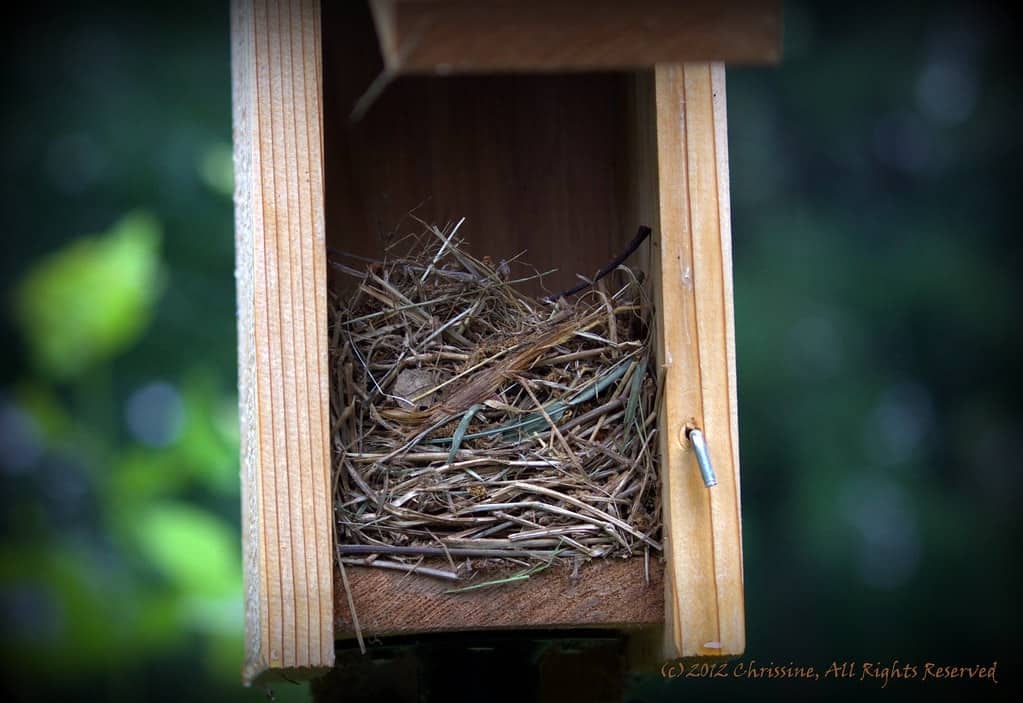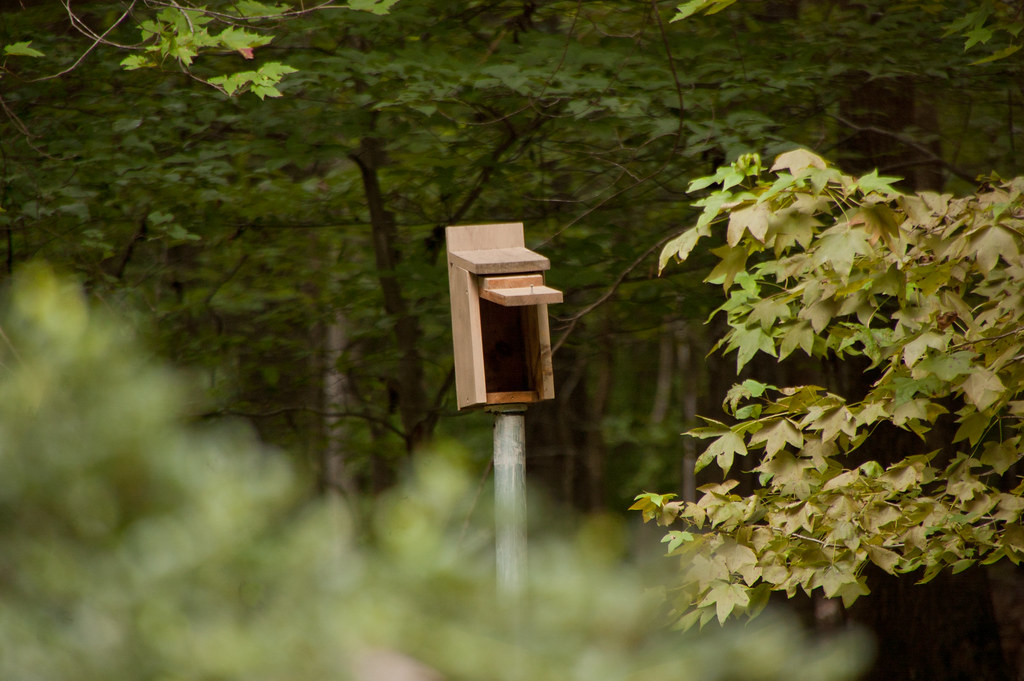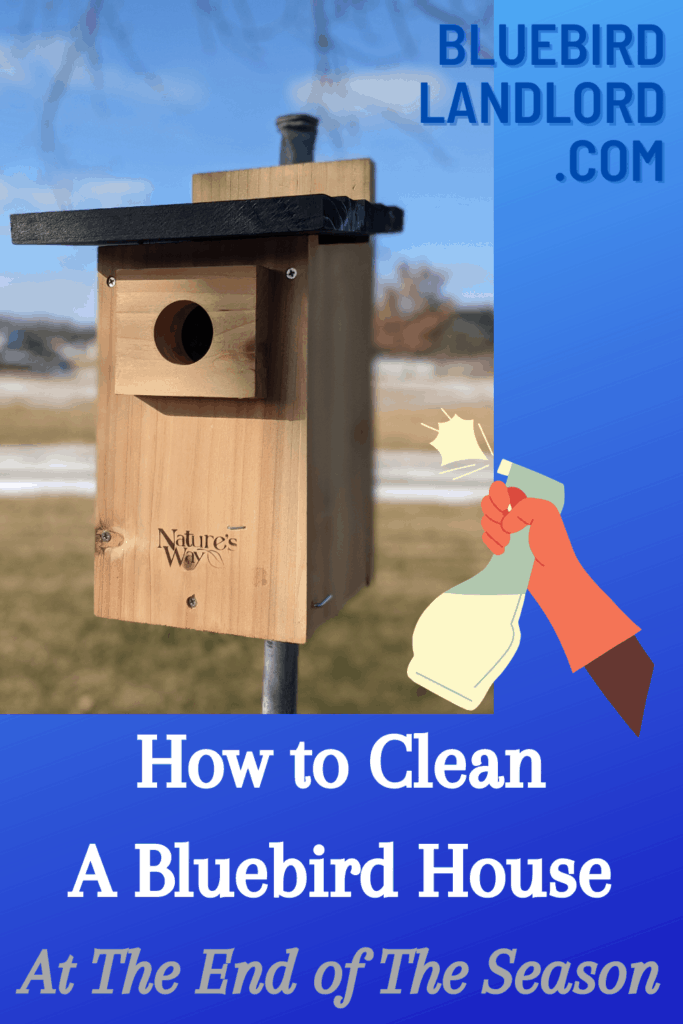
It is important to have your bluebird house (nest box) set up and ready to go by early spring. This way you’ll be ready for bluebirds at the beginning of the nesting season. But, what do you do with your nest box at the end of the nesting season? After a decade and a half of monitoring bluebirds, I recommend thoroughly cleaning out your bluebird house at the end of the nesting season. In this article I’ll show you how to clean a bluebird house at the end of the season.
The photo above by Chrissine Cairns is licensed under CC BY-SA 2.0
To clean out your bluebird house at the end of the season, follow these four steps:
1. Determine whether or not the nesting season is truly over
Since it is illegal in North America to remove active nests of native, cavity-nesting birds, it’s extremely important to be sure that the nesting season is actually over before you clean out your bluebird houses. So, when does the nesting season end for bluebirds?
As a general rule, the bluebird nesting season ends in mid-August for the three species of bluebirds in North America. Even in states like South Carolina, which have higher fall temperatures, bluebirds will have usually fledged their last nest of young by the middle of August (source).
So, if your nest box is empty and it’s the middle of August, you can go ahead and clean out the nest box. The end of the nesting season is upon you. But, what if there’s still a nest in the bluebird house?
How to determine if a bluebird nest is old or new
If your bluebird house still contains a bluebird nest at the end of the season, you might wonder if it’s an active nest or an old nest. This is why weekly monitoring of your nest boxes is so important. If you monitor your nest boxes weekly, you’ll have no doubt when your last nest full of bluebirds flew away.
In general, an old bluebird nest will be flattened and there may be fecal matter on the nest and walls of the bluebird house, whereas a new bluebird nest will be tall, clean, and have a rounded nest cup in the center or back of the nest box.
Near the end of the nesting season, if you find a new nest in your bluebird house, leave it alone and wait until you can be sure that is going unused. But, if you are sure it is an old nest, go ahead with cleaning out the nest box.
Once you’ve determined that the nesting season is over, you can move on to the actual cleaning.
2. Remove all nesting material from the bluebird house

Once you’ve determined that your bluebird house is no longer being used, you should then remove all of the nesting material from the bluebird house.
There may just be scraps of nesting material from a previous nest, or even a fully used nest that has been flattened by the baby bluebirds upon their exit from the box.
Either way, remove all of the nesting material and dispose of it in a different location. Generally speaking, you don’t want to throw bird nests directly on the ground because they might encourage predators to come check out the nest box.
3. Scrape off all waste from the bottom and sides of the nest box
Next, scrape off any waste that you find off of the bottom and sides of the nest box. For this job, you can use any type of metal or plastic scraper.
Bluebird nestlings will typically leave fecal residue at the bottom of the nest box (from relieving themselves during their almost month-long stay in the nest). So, you will usually find some harmless waste on the bottom, and possibly the sides, of the nest box too. This is what you want to remove at the end of the season.
The residue is actually fine to leave during the nesting season. Bluebirds will build their second and third nests right on top of it – they don’t mind at all. But, at the end of the season, take a few minutes to remove this waste from your nest box with a scraper. This will give you a clean nest box for the following year.
After cleaning the nest box free of waste and stains, it’s time to sanitize it.
4. Sanitize the bluebird house with a bleach-based cleaning solution
The next step to clean out your bluebird house at the end of the season is sanitizing it with a bleach-based cleaning solution.
While technically optional, the intention with this step is to stop the spread of any parasites that might be present in the nest box. A bleach solution should do an effective job of removing common parasites from bluebird houses.
You can make your own bleach and and water solution (1 part bleach to 10 parts water), or use a commercial product like Clorox Cleanup (here’s a link to Clorox Cleanup on Amazon).
Spray the bluebird house fully with bleach solution, making sure to cover the bottom and sides of the nest box. Then, leave the nest box door open to let it air dry.
5. Let the nest box dry out completely before closing it

The last step is to let your bluebird house dry out completely before you close it. Leave it outside to dry with the nest box door open for about 24 hours. By that point, the chlorine should have oxidized and the nest box should be dry. It will now be clean and you are free to close it – it’s ready for the next season!

Other considerations for the end of the nesting season
There are a few more questions you may be asking yourself at the end of the bluebird nesting season. I will do my best to answer a few of these questions below.
Will bluebirds use nest boxes during the winter?
Bluebirds do NOT use nest boxes for the purpose of nesting during the winter months. However, they do use bluebird houses in the winter as a form of cover to shield them from wind and cold temperatures. So, this is why you might see bluebirds entering and exiting your nest boxes from September through January, even though it’s outside of the nesting season.
Should I take my bluebird houses down for the winter?
Since there is the potential that bluebirds will use your nest box as a form of cover during the winter, feel free to leave it up all year long. This is my preferred option because it is more convenient for me. But, some people choose to store their bluebird houses indoors for the winter to extend the life of the nest box. This is fine too, just make sure to store your nest box in a dry area where it won’t be damaged or forgotten by the following year.
What other animals use bluebird nest boxes during the winter?
Many other cavity nesting birds will take refuge in your nest box during the winter – chickadees, titmice, and woodpeckers, just to name a few. Other interesting creatures that you might find in your bluebird house during the winter are mice and roof rats.
Mice and rats are generally harmless during the winter, but may pose a problem if they become protective of the box during the nesting season. If you experience problems with mice or roof rats in your bluebird houses, consider reading this article at Sialis.org to take steps to deter them.
Conclusion: How to Clean a Bluebird House
Bluebird nest boxes are fairly easy to clean at the end of the nesting season. But, as easy as it can be, it’s something that you might completely forget to do come August! So, I hope this article has been helpful in explaining how to clean your bluebird nest box in the most straight-forward way possible.
If you are looking for a new nest box, or possibly a different style of nest box, check out the ones that I use myself on my Recommended Tools page here.



